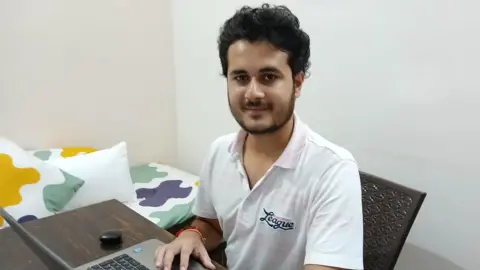 Anurag Garg
Anurag GargWhen ChatGPT burst onto the scene in late 2022, PR agency founder Anurag Garg was eager for his team of 11 to quickly incorporate the technology into their workflow so the business could keep up with its competitors. .
Mr. Garg encouraged his employees to use the AI language tool for the agency’s long list of day-to-day tasks, ranging from generating story ideas for clients, topics to pitch to the media and transcribing meeting notes. and interviews.
But instead of increasing team productivity, it created stress and tension.
Staff reported that tasks were actually taking longer as they had to create a summary and requests for ChatGPT, while also having to double-check their output for inaccuracies, of which there were many.
And every time the platform was updated, they had to learn its new features, which also required additional time.
“There were too many distractions. The team complained that their tasks were taking twice as long because we now expected them to use AI tools,” says Mr. Garg, who heads Everest PR and splits his time between the US and India.
The whole point of introducing AI to the company was to simplify people’s workflow, but it was actually giving everyone more work to do and making them feel stressed and burned out.”
As a business leader, Garg also began to feel overwhelmed by the growing number of AI tools being launched and felt he had to keep pace with each new addition. Not only was he using ChatGPT as his team, but Zapier to track team tasks and Perplexity to fill out client research.
“There is an overabundance of AI tools on the market, and no single tool solves multiple problems. As a result, I had to constantly keep tabs on multiple AI tools to run tasks, which became more of a mess. It was difficult to keep track of which tool was supposed to do what, and I started getting completely frustrated,” says Mr. Garg.
“The market is flooded with AI tools, so if I invest in a specific application today, there is a better one available next week. There is a constant learning curve to stay relevant, which I found difficult to manage, leading to burnout.”
Mr Garg backed away from the mandate that the team must use AI in all their work, and now they use it mainly for research purposes – and everyone is much happier.
“It was a learning phase for us. The work is more manageable now as we are not using many AI tools. We’ve gone back to everything being done directly by the team, and they feel more connected and involved in their work. It’s much better,” says Mr. Garg.
 Getty Images
Getty ImagesThe stress that Mr. Garg and his team’s experience using artificial intelligence tools at work is reflected in recent research.
In freelance platform Upwork’s survey of 2,500 knowledge workers in the US, UK, Australia and Canada, 96% of top executives say they expect the use of AI tools to increase their company’s overall productivity levels – by 81% who admit that they have increased the requirements for workers during the past year.
However, 77% of employees in the survey say that AI tools have actually decreased their productivity and increased their workload. And 47% of employees using AI in the survey say they have no idea how to achieve the productivity gains their employers expect.
As a result, 61% of people believe that using AI at work will increase their chances of experiencing burnout – rising to 87% of people under 25, as found in a separate survey of 1,150 Americans, by resume writing company Resume Now.
The Resume Now survey also highlights how 43% of people think AI will negatively impact work-life balance.
Whether the technology is based on AI or not, surveys suggest that many workers are already feeling overwhelmed.
A further study from work management platform Asana highlights the effect of introducing more work-based apps.
In its survey of 9,615 knowledge workers across Australia, France, Germany, Japan, the UK and the US, it found that, of those who use six to 15 different apps in the workplace, 15% say they missing messages and notifications due to the number of tools.
For those who use 16 or more, 23% say they are less efficient and their attention span is reduced due to constantly switching apps.
As Cassie Holmes, a management professor at the University of California, Los Angeles, commented in the study: “Using multiple apps takes extra time to learn them and switch between them, and that wasted time is painful because we’re very sensitive to wasted time. “
 Gemma shoots people
Gemma shoots peopleLawyer-turned-coach Leah Steele now specializes in helping legal professionals overcome burnout, with many feeling burdened by the increased workload demands of their companies following the introduction of AI-based productivity tools. It’s an experience she’s familiar with, as the introduction of a new technology platform in a previous role saw her client caseload grow from 50 to 250.
“The biggest thing I’m seeing is this constant competitive demand to do more with less – but companies aren’t really thinking about whether the systems and technology they’re introducing is delivering a result that isn’t useful,” Bristol says. – based on Mrs. Steele.
“Everything is moving so fast. It’s a constant battle to keep on top of things to develop expertise in such an advanced field.”
The burnout lawyers are experiencing now, Ms. Steele adds, is not just about the increasing volume of work technology and AI tools are facilitating, but also the impact of the effects.
“When we’re looking at burnout, it’s not just about the volume of work we’re doing, it’s how we feel about the work and what we get out of it,” Ms Steele says.
“You can feel stressed about ending up in a high-volume, low-control environment when what you originally wanted to do was interact personally with customers and make a difference for them.”
Ms Steele adds: “You may also feel stressed about the risk of losing your job and the fear of being replaced because you are no longer enjoying work as it has become so technology-driven.”
The Law Society of England and Wales recognizes that lawyers need better support from law firm leaders to get the most out of new technology such as AI.
“While AI and new technologies can make legal work more efficient by automating routine tasks, they can also create more work for lawyers, not less,” says President Richard Atkinson.
“Learning to use these tools takes time and lawyers often have to undertake training and adapt their work processes. Many technologies were not originally designed for the legal sector, which can make the transition more challenging.”
 flew
flewAlicia Navarro is the founder and CEO of Flown, an online platform and community that helps people focus on “deep work”—tasks that require sustained concentration. She agrees that there is an “avalanche” of AI tools, but says they must be used correctly.
“There’s such a huge amount of filtering and learning that needs to be done before these tools start to become productive elements in our lives.”
But she argues that for small firms with limited resources, AI can be a big help.
“It’s an incredibly empowering thing for start-ups to be able to do a lot more, or for companies to be able to pay more dividends or pay their team more.”

